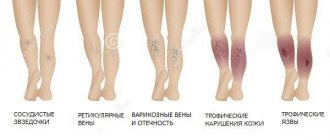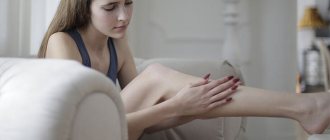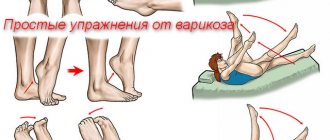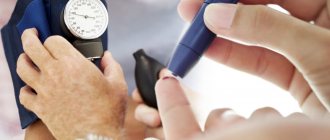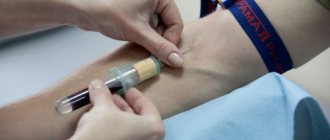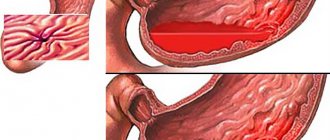The main cause of varicose veins of the lower extremities is impaired functioning of the venous valves. As a result of the development of valvular insufficiency, blood flows back into the saphenous vein system, which leads to chronic venous insufficiency. The progression of the disease can be prevented with compression. Phlebologists at the Yusupov Hospital recommend that patients use bandages for varicose veins of the lower extremities.
Compression treatment of veins is carried out using elastic knitwear (socks, stockings, tights). Phlebologists at the Yusupov Hospital conduct a comprehensive examination of the patient using modern research methods and determine the degree of chronic venous insufficiency. Doctors select knitwear for each patient that provides one or another compression, and the most effective medications. If conservative therapy is ineffective, surgeons perform classical and innovative surgical interventions. Medical personnel teach patients how to properly bandage varicose veins with an elastic bandage after surgery. Phlebologists determine how long to wear bandages after vein surgery individually, depending on the type and severity of the surgical intervention.
Compression therapy - why and what it is needed for
If you notice dark, bulging, unsightly veins on your legs and/or thighs, you likely have varicose veins. You may have heard that compression stockings can prevent them or relieve symptoms. You may already have varicose veins, but you haven't worn compression garments before and don't want to start using them. Therefore, the benefits of using compression therapy for varicose veins need to be well explained.
Modern compression jersey looks very nice
To do this, it is necessary to once again explain what varicose veins are, as well as the causes and risk factors for its development. In addition, you need to figure out when it is better to wear compression hosiery for varicose veins, how to buy it, put it on and use it correctly.
Overlay technique
Depending on where the bandage is applied, a strict sequence of actions must be followed.
Ankle bandage
How to bandage your leg with an elastic bandage in the ankle area:
- The ankle should be wrapped with an elastic bandage, starting with two turns around the ankle.
- Then make two turns, starting from the back of the foot;
- Next, wrap the bandage around the ankle again.
- Repeat the required number of times until the entire ankle is secured with an elastic bandage.
- The bandage is secured under the ankle.
Wrist band
When bandaging your wrist:
- The bandage is fixed in one turn around the wrist.
- Stretch it from the back of the hand between the thumb and index finger, then return through the palm to the wrist.
- After this, the bandage is pulled through the palm and returned to the wrist.
- Repeat the required number of rounds of the bandage until the joint is completely fixed.
- Attach a bandage to your wrist.
Knee (or elbow) bandage
When applying the bandage, the knee or elbow should be in a comfortable flexed position.
- Wrap the bandage two turns below the joint.
- From the back of the arm or leg, the bandage is pulled above the joint and made two turns.
- Perform overlapping turns above and below the joint until it is completely closed.
- Secure the end of the bandage in a convenient place below or above the joint.
General recommendations
- You need to wind the elastic bandage, overlapping each next turn with the previous one by no less than a third of the width and no more than half.
- The tension of the bandage should be loosened as you move from the narrow part to the wide part.
- The bandage should not have gaps or folds.
- It is convenient to use self-fixing bandages.
What are varicose veins?
If you have blue, twisted veins that are located near the surface of the skin, bulging and uncomfortable, you probably have varicose veins. Although theoretically these veins can occur in any part of the body, in the vast majority of cases they are located in the lower extremities.
Spider veins are much smaller than varicose veins and are usually located near the surface of the skin. Varicose veins can be located both close to the surface of the skin and deep in the subcutaneous tissue. In the latter case, they are difficult to determine without instrumental research methods. Spider veins can be blue, red, or purple in color and often look like spider webs or tree twigs. Spider veins often appear not only on the legs, but also on the face. They are caused by the same mechanisms as varicose veins, but do not usually lead to the complications caused by varicose veins.
In addition to clearly visible signs of bulging and curving blood vessels, symptoms of varicose veins include:
- Swelling of ankles and feet.
- Feelings of pain, heaviness, or aching in the legs.
- Pulsation or spasms in the lower leg muscles.
- Itching in the legs, especially in the lower leg and ankle, manifests itself as dry skin.
- Darkening and change in skin texture.
- Venous ulcer.
Although varicose veins are not aesthetically pleasing, they do not always lead to serious serious complications if the disease is treated correctly. Varicose veins can also lead to a condition called varicothrombophlebitis, which occurs when blood clots form in a vein near the surface of the skin. This condition is characterized by swelling, pain and redness. The development of varicothrombophlebitis signals a significant circulatory disorder, which also causes other complications of varicose veins. If you have varicose veins or just spider veins, don't ignore them. Instead, you need to visit a phlebologist, undergo a consultation and duplex ultrasound scan of the veins of the lower extremities. Next, you need to discuss with your doctor the tactics of treatment and prevention, the necessary changes in lifestyle to prevent complications and progression of varicose veins.
TRAINER'S TIPS
Athletes know: no training session begins without a preliminary warm-up. Why do you need a warm-up? A set of simple exercises will warm up the muscles of the body, making the circulatory system and musculoskeletal system ready for stress. The risk of injury will be significantly reduced. The physiological effect of warming up is explained by the fact that human organs and systems have a certain inertia and are not able to immediately engage in action. Warming up should be performed in low-intensity mode for 5-15 minutes.
Tennis players who tirelessly hit the ball with their rackets suffer from professional pain in the elbow joint. Runners and football players suffer from meniscus prolapse. The painter's fingers, being in one position for hours, sometimes refuse to hold the brush. A graphic artist, who clicks a computer mouse day after day, is surprised to notice that his hand begins to cramp. The legs of an office worker, crossed all day under the table, and the legs of a salesperson standing behind the counter get tired. All those who have experienced increased physical activity for a long time - ballet dancers, surgeons - are also susceptible to the disease.
If your profession is in a “risk zone” and involves long periods of standing (teachers, salespeople, hairdressers, waiters), working in a monotonous position (ticketeers, accountants, cashiers) or heavy load on the hands (turners, loaders), You have the power to prevent occupational diseases or mitigate and alleviate their manifestations. Daily wearing of elastic medical bandages or TONUS ELAST bandages will relieve pain, warm tired muscles, and you will feel the relief you have long dreamed of.
Chronic venous insufficiency and varicose veins
Varicose veins often manifest as symptoms of chronic venous insufficiency, which occurs when venous outflow in the lower extremities is impaired. The valves in our veins control blood flow; when they work properly, the blood in the veins flows in only one direction, from the distal portions to the heart. When the valves in the veins stop functioning normally, blood flow slows, contributing to the development of symptoms of chronic venous insufficiency.
Chronic venous insufficiency and varicose veins do not occur spontaneously on their own. The following factors often contribute to the development of varicose veins and chronic venous insufficiency:
- Sitting or standing for long periods of time.
- Deep vein thrombosis.
- Trauma to the lower limb as a result of surgery.
- Family history of venous insufficiency and varicose veins.
- Gender (women are more likely to develop varicose veins than men).
- Pregnancy. The growing fetus puts pressure on the veins of the abdominal cavity, changing hemodynamics in the lower extremities.
- Age (aging processes weaken the valves of blood vessels).
- Overweight or obesity (excess weight puts extra strain on your veins).
- Weak motor activity.
- Smoking.
If you have a combination of these risk factors, you need to visit a phlebologist and undergo an appropriate examination. You should also pay close attention to your doctor's recommendations on how to keep your veins healthy and prevent problems such as varicose veins from developing in the future.
THE NATURE OF VARICOSIS
Our blood vessels function continuously, like a busy two-way highway, pumping 4,500 liters of blood through the heart per day. Through the arteries, blood is directed from the heart to the lungs (the natural force of gravity helps it in this), enriched with fresh oxygen, washes the internal organs, and then, already spent, returns back through the veins. The way up is more difficult, and here the calf muscles help perform the pump functions: contracting with every movement, they force the veins to contract and the blood flows upward. To prevent the flow of blood from being disrupted, nature created special shutter valves on the inner walls of the veins that open only in one direction.
If you stand or sit for a long time, blood accumulates in one place, the veins dilate, and the valves can no longer reliably block the reverse flow (Fig. 2). The veins lose their elasticity, become deformed and appear as unsightly nodes on the skin of the legs (Fig. 3).
Compression therapy for varicose veins (mechanism of action)
Compression therapy for varicose veins helps to apply a certain pressure on the blood vessels, preventing the accumulation of blood and promoting proper one-way blood flow. Compression stockings can also help manage swelling, especially if you wear compression stockings in the morning before you begin physical activity, which is when leg swelling occurs. The dense tissue prevents the veins from expanding as usual, which helps blood flow faster. Thanks to the combination of these effects, compression stockings for varicose veins can help relieve soreness, aching sensations, as well as muscle throbbing and spasms. However, you should discuss the use of compression stockings with your doctor to avoid possible side effects and complications.
The mechanism of action of compression hosiery for varicose veins
If you already have varicose veins, compression stockings can help relieve symptoms and improve the appearance of your lower legs. In modern practice, compression products of varying degrees of compression, and therefore clinical effect, are used.
- Compression stockings class 1, 15-20 mm Hg. They provide moderate compression and are recommended for prophylaxis in healthy people, as well as in case the patient refuses a higher level of compression.
- Level 2 compression, 20-30 mm Hg, is more effective and relevant for patients with varicose veins.
- 3rd compression level, 30-40 mm Hg. Art., provides significant pressure. In some clinical situations it will be the most appropriate.
- 4th compression level, 40-50 mm Hg. Art. This knitwear is used in selected clinical cases under close medical supervision.
Popular brands
Elastic bandages are available in a wide range of pharmacies. The most popular include:
- "Intex". One of the largest Russian manufacturers of bandages and compression hosiery. It produces products of all degrees of extensibility, 1.5-5 meters long and 8-10 centimeters wide. Particularly noteworthy are the Venoprof line tapes with silver ions, thanks to which faster healing of venous ulcers occurs. These bandages contain a high percentage of cotton, are securely fixed and comfortable to use.
- The Latvian company Lauma offers elastic bandages, the latex threads of which are completely covered with natural cotton fiber. Thanks to this, they absorb moisture well and are ventilated, and practically do not cause allergic reactions. In addition to standard size products (3 meters long, 8-10 centimeters wide), they produce bandages 12 cm wide and 5 meters long.
- "Tone". The Russian factory, located in Bryansk, produces elastic tapes of all types of elongation with a multi-layer structure, consisting of 80% cotton. The bandages are easy to use thanks to the Velcro fastening system. The products retain their compression properties for a long time.
- Another Russian in Smolensk. They produce affordable elastic bandages with a porous structure that do not cause allergies. They contain latex, polyamide and cotton. Metal fasteners are included with the bandages.
- The German company Hartmann produces elastic bandages in a wide range: self-fixing products with a special fabric structure that do not contain latex; thin ribbons of different colors with polyamide, viscose and cotton; body bandages with latex thread wrapped in cotton, length from 3 to 10 m, width from 5 to 12 cm.
The German company Hartmann produces the thinnest products
How to choose compression hosiery for varicose veins
Once you have determined the required level of compression with your healthcare provider, you will need to purchase a specific product.
The best compression stocking available today
Leading criteria for choosing compression hosiery:
- Length of compression product. Varicose veins can occur both only on the legs and throughout the entire lower limb. The location of your varicose veins will influence which type of compression garment you should choose. If you have varicose veins only within the shins, then you should pay attention to knee-length compression socks. If varicose veins are on the legs and thighs, then groin-length stockings will be the best choice. Some patients in this case prefer compression tights.
- Choosing the size of compression hosiery. This aspect can be entrusted to specialists in a specialized salon or you can measure the parameters of the lower limb yourself. In the latter case, you may need to measure the circumference of your ankle, calf and/or thigh. On your own or with the help of a specialist, you will need to compare the measurement data with the size table to find your personal size. Choosing the right compression garment size is very important: if it is too small or large, the compression stockings will not provide the right level of pressure. This will lead to the ineffectiveness of compression therapy or the impossibility of using hosiery.
- Choosing a compression product style. The modern compression products industry offers a wide selection of fabrics, styles and product shapes. You need to make a choice between opaque or transparent fabric, the presence or absence of a pattern, closed or open toe. You will also need to choose a color, which varies from product to product. Basic neutral colors such as black, beige and white are almost always available. Certain types of compression products are presented in bright solid colors, and there are options with various patterns.
What is better to use in the postoperative period?
During the operation, thin walls of blood vessels are always damaged, and as a result of these damages, substances enter the blood that slow down blood flow and increase blood clotting. Patients are advised to use compression garments only to prevent the formation of blood clots and blood clots.
During the postoperative period, patients are always inactive and it is very difficult for them to care for themselves. Therefore, it will be much more effective to use stockings than a bandage.
Using elastic bandages for varicose veins
Currently, there are not many situations where modern experts recommend compression bandages, but still in some clinical cases this is not without meaning.
Compression bands can be adjusted to achieve different levels of pressure, which is both an advantage and a significant disadvantage. Even medical workers do not always apply compression bandages correctly, which leads to undesirable effects. What can we say about ordinary patients? In situations with unstable edema, compression bandages may have a better effect than compression stockings. The difficulty lies in applying compression bandages, which is best left to professionals. Otherwise, the target effect of compression therapy may not be achieved. And in the worst case scenario, complications arise from the improper use of compression bandages. Therefore, in the vast majority of cases, modern specialists choose compression hosiery as a more controlled and universal means of helping patients with varicose veins.
Why? Let's look at the model - stockings for surgery:
- This model of stockings is produced in white color - this allows specialists to monitor the patient’s veins during the operation itself, white color also makes it possible to monitor the healing process of a postoperative wound or suture, and a specially provided hole for the foot allows the nurse to monitor the patient’s body temperature;
- It is much easier and more convenient for the operating nurse to put on stockings without disturbing the patient.
The main advantage of using hospital stockings during surgery is that they are easier to put on and do not slip down after the patient returns to the room. For childbirth, as well as for surgery, stockings are preferable to bandages for the same reasons.
The use of compression therapy in the treatment of varicose veins
Compression therapy today is an integral part of the process of radical treatment of varicose veins. It is difficult to imagine any intervention on the veins of the lower extremities today without an important component of compression. In the version that has become classic, compression stockings or knee socks are used for three to four weeks after intervention on the veins of the lower extremities. The goals of compression therapy in this case are: prevention of complications and side effects of the intervention, relief of symptoms of chronic venous insufficiency. In some cases, the period of use of compression hosiery may be increased or decreased.
Most people can wear compression stockings for varicose veins without any side effects. However, you should discuss the situation with your healthcare provider if you experience redness, skin imperfections, pain, numbness, or swelling while using compression products. If you want to stop using compression stockings due to discomfort, talk to your doctor first. Perhaps the reason is an unsuccessfully chosen size, type, or insufficiently high quality of the compression product.
Quality, comfort and convenience of compression hosiery
Compression therapy cannot cure varicose veins on its own, but it can help manage symptoms and improve circulation and overall quality of life. If you are already at risk of developing varicose veins based on the criteria discussed above, you can consult a phlebologist and use products with a certain degree of compression. In combination with lifestyle changes, compression stockings or knee socks will also be the best prevention of the development or recurrence of varicose veins.
DOCTOR'S ADVICE
The most important rule is to constantly move your wrist to avoid hardening, which can take months to get rid of. To restore and strengthen your wrist, stretch the surrounding muscles by bending your fingers towards your elbow and holding them in this position for 30 seconds. When you feel pain, stop. If everything is fine, try rolling a 5-centimeter lump of plasticine in your fingers for 30 seconds. Over the course of a week, increase to a few minutes. When rehabilitating when lifting weights, start with lighter weights and perform more repetitions. In case of pain, inflammation or swelling, it is necessary to cover the injured area with ice wrapped in a towel. If the pain continues, consult a doctor.
Patient questions about compression therapy
Can varicose veins (varicose veins) be treated with compression stockings?
Compression stockings or knee socks will help cope with some of the symptoms of varicose veins (swelling, heaviness), and compression is also a good prevention of complications of varicose veins. However, only removal of varicose veins can completely rid you of such a disease as varicose veins.
Is it useful to wear compression hosiery for varicose veins? Will it impair blood circulation?
The use of compression hosiery improves pathologically altered hemodynamics in varicose veins and has an extremely positive effect.
Can compression stockings be used for trophic venous ulcers?
The use of compression therapy in the presence of a trophic venous ulcer is a necessary component of treatment, without which it is almost impossible to achieve healing of the ulcer.
How long should I wear compression after surgery?
Most patients are advised to wear compression stockings for about three to four weeks after varicose vein surgery. In some cases, the period of wearing compression can be changed upward or downward.
How to put on stockings correctly?
There are specially designed gloves on sale that make putting on stockings easier. If for some reason this accessory was not delivered to the hospital, you can learn how to put on a compression product yourself without gloves, just try not to damage the fabric of the compression stocking.
Turn the stocking inside out all the way to the bottom and carefully insert your leg. Then you need to carefully straighten the knitted fabric and, using your palms, slowly put on the stocking, gradually turning it inside out.
Do not forget to smooth out the wrinkles and slowly, slowly, put on the stocking. This way the material will fit tightly onto the surface of the body and the stocking will not slide down.
Possible mistakes
- Bandaging only the affected areas. The bandage must be applied to the entire leg.
- The pressure is distributed incorrectly: it decreases not from top to bottom, but from bottom to top.
- The bandage is not secured at the top correctly, for example, with pins, but it should be with an adhesive plaster.
- Bandaging the ankle and foot without a figure eight, and, as a result, low pressure in the foot.
- Using an old bandage that has become unusable.
- The bandage is applied unevenly, which means the compression is ineffective.
- The distance between turns is too large.
- The distance between the turns is too small, and the bandage does not reach the popliteal region, but only the calf.
